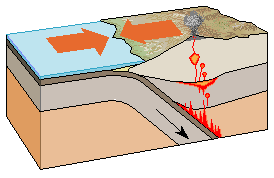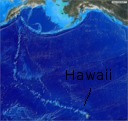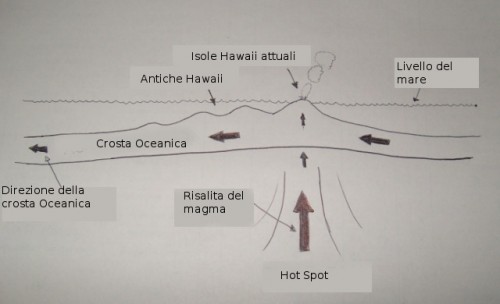Stefano Rossignoli 30 marzo 2010 (revisionato il 28 luglio 2017)
La revisione del luglio 2017 è dovuta a un mio errore piuttosto grave nella spiegazione della causa dell’espansione degli oceani. Mi è stato fatto notare in modo molto antipatico e irrispettoso ma, avendo ragione chi me l’ha fatto notare, almeno dal punto scientifico, ho voluto correggere l’articolo sfruttando appieno il buono di una persona estremamente preparata, seppur frustrata e incattivita…
Il discorso è quanto mai ampio, ma cercherò di affrontarlo nel modo più semplice possibile in modo da consentire la lettura a chiunque o quasi.
Gli oceani si formano è vero e per lo stesso motivo per cui si formano, possono anche chiudersi.
Si formano, si chiudono, (si muovono di conseguenza anche i continenti formati da ‘crosta continentale’ a stretto contatto con la crosta oceanica) e cambiano continuamente posizione.
Come Federica Colombo ci spiega, tanto tempo fa c’era la Pangea, un grande supercontinente in cui le terre emerse che conosciamo oggi erano più o meno tutte attaccate tra loro, ma prima si sono formati altri supercontinenti a causa dei lenti e inesorabili movimenti delle placche continentali.
Un oceano inizia a formarsi quando un continente (o meglio una parte di crosta continentale) si spezza lungo una frattura lunga anche migliaia di chilometri e i due margini della frattura iniziano ad allontanarsi.
Ma cosa può muovere o addirittura spezzare interi continenti?
Un ragazzino di terza elementare forse direbbe:”Il magma!”.
E avrebbe ragione!!!
Per il fatto che il magma (la roccia fusa che sta sotto la crosta terrestre) è caldo e quindi meno denso delle rocce solide, questo tende a salire, a muoversi in senso circolare (come indicato qui sotto in figura) e anche a effondere o, se preferite, ad eruttare.
Non solo affiora durante le eruzioni vulcaniche che conosciamo tutti …pensate all’Etna, vulcano di casa nostra che molto spesso si mette ‘in attività’, ma il magma può effondere anche lungo spaccature di dimensioni e lunghezza enormi, chiamate ‘Dorsali‘.
Sotto le dorsali il magma si muove con movimenti circolari detti MOTI CONVETTIVI che vi spiegherò prestissimo in questo articolo dedicato (I moti convettivi e la Tettonica delle Placche).
Il magma del Mantello funziona quindi un po’ come un nastro trasportatore cha una elevatissima forza ed è in grado di spostare intere masse continentali.
La velocità di spostamento è nell’ordine del centimetro all’anno (0-20cm/anno) ed è mediamente regolare.
Esistono attualmente sulla Terra decine di migliaia di chilometri di dorsali.
Lungo le dorsali viene prodotta anche nuova crosta terrestre, più precisamente ‘Crosta Oceanica’.
Il Magma infatti, che erutta sotto forma di Lava (ovvero magma senza quasi più gas al suo interno!), solidifica aggiungendo regolarmente un “nuovo pezzetto” di crosta oceanica…
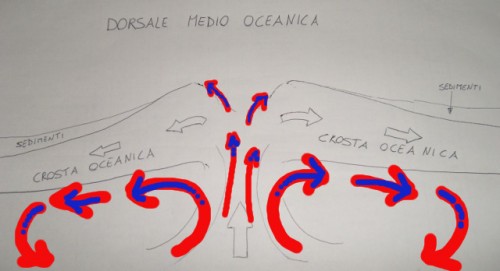
E’ questa la caratteristica principale di un oceano: La presenza di MOTI CONVETTIVI, di una dorsale e la formazione di nuova crosta oceanica che inizia ad allontanarsi regolarmente, in direzione perpendicolare alla dorsale stessa.
Nella situazione in cui la crosta oceanica prodotta va direttamente a spingere sul margine di un continente (Margine Continentale Passivo), anche il continente si allontanerà dal centro della dorsale avendo come conseguenza l’espansione dell’oceano. Questa è la situazione dell’Oceano Atlantico.
Nell’oceano Pacifico c’è ovviamente una dorsale, ma la nuova crosta che viene prodotta, dopo il suo tragitto (più o meno lungo), va ad immergersi e a scivolare sotto il continente (Margine Continentale Attivo).
Questo fenomeno di ‘immersione’ della crosta oceanica sotto la crosta continentale viene chiamato subduzione.
Ne consegue che l’Oceano Pacifico si sta restringendo nonostante la continua produzione di Crosta oceanica!
Questi movimenti sono misurabili più o meno direttamente, certo non con il metro!
Vediamo ora un modo semplice per capire che la crosta oceanica si muove allontanandosi dalla Dorsale.
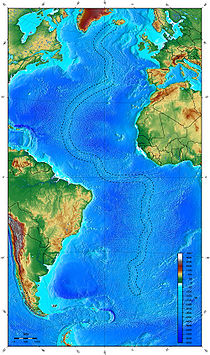
Se osservate una mappa del fondo oceanico, mediamente nel mezzo degli oceani ci sono delle enormi catene montuose che sono appunto le Dorsali Medio Oceaniche.
Se poi andate in corrispondenza delle isole Haway (USA – Oceano Pacifico) noterete che esse sono anche un sistema di monti sottomarini allineati più o meno in direzione Est-Ovest e la dorsale si trova ad est, cioè alla loro destra.
Le isole Haway sono anche un insieme di isole Vulcaniche caratterizzate da attività vulcanica persistente in quanto si trovano su un Punto Caldo (Hot Spot) in cui il magma del mantello risale costantemente.
Il punto caldo è grossomodo fisso quindi, mentre la crosta oceanica gli transita sopra, essa si rigonfia in coni vulcanici. Quelli che troviamo ad OVEST delle Haway sono gli antichi vulcani ormai ‘spenti’ che corrispondono al momento in cui quella parte di crosta oceanica transitava sopra l’Hot spot.
In conseguenza a questo fenomeno, ad EST delle Haway non trovate vecchie isole perchè la parte di crosta che si trova ad EST deve ancora passare sopra il Punto Caldo…
Questo è solo uno dei tanti esempi per capire che gli oceani si formano, si ‘aprono’ e si ‘chiudono’ e che il nostro pianeta cambia ed è in continua evoluzione. La Terra è un libro aperto, ma per comprenderlo bisogna imparare il suo linguaggio!!!
